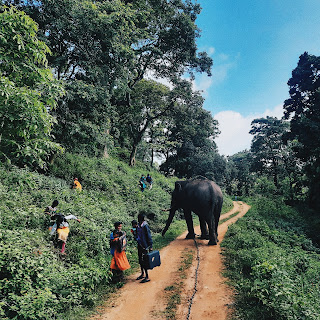How do we coexist?
This picture is from the periphery of BRT Tiger Reserve in Southeast Karnataka, home to a variety of wild beings, and the Soliga indigenous community. If you notice the chain tied to the elephant's leg you would infer that it is a captured/domesticated elephant, and you would be correct. This is Gajendra, captured by the forest department many years ago, and now roams around the forest department quarters as well as inside the forest. You cannot, however, see the other end of the chain. Gajendra is not tied to anything from the other end. He roams freely across the highway and on forest trails. Here, he is grazing close to a Soliga settlement inside the forest in the morning. A time that coincides with the Soliga residents having to catch the single bus in the day that leads them out of the forest to the city, to schools, places of work, and more.
We were coming out of the forest after the morning safari, when we came across this scene. A couple of Soliga families climbed up to the trail to walk to the highway, when they saw Gajendra doing his thing right in the middle of their way. Gajendra has a human-given name and a chain tied to his leg, but an elephant he is. The Soligas were terrified of angering Gajendra, so after some discussion, they decided to trek up a few metres and cross the massive being. The slope they were now traversing, by the way, was the very spot we caught a leopard chilling in the evening on a previous trip.
Remembering this simple interaction makes me think about coexistence, the meanings and philosophy that the word carries; a word that's often thrown around in conservation conversations, and also commercial greenwashing messages.
What does the word itself tell us? Coexistence makes a claim about existence - a word that students of philosophy hate, and love, and which drives them crazy. Existence: something to do with how and why and what exists in space. And time. And being. How do humans exist? How do humans exist in a forest (or a desert? Or the coast?)? How do humans exist in a forest today (as opposed to 15 years ago?)? Why do they exist in a forest today? But also, how do elephants exist? Do we answer in the "being", or the "doing"? Do we invoke science (imagine an ecologist explaining elephant behaviour and ecology with an arrogance that's often seen but difficult to explain) or morality (imagine a 60-page essay on a confusingly obvious word *cough*)? As with most words conservationists use, I believe there is too less clarity within the word itself that is left unacknowledged, before we move to the "right and wrong" of coexistence.
Say we define/decode it in some (pretty boring) universe. What then? The word "should" creeps into sentences. Should humans and elephants coexist? How should they coexist? How much space should be claimed by whom? How should we decide things about coexistence when one of the (or sometimes both) parties involved is not capable of making sense of the moral decisions we make for it or engaging in the discourse? Why should coexistence be considered "good"? What about the normative ethics of coexistence - whether coexistence implies negative or positive acts? Questions may seem to have obvious answers, but they rarely do.
Parallel to this are questions that arise from the ethics of non-human beings. Our conception of the ethical boundaries of the elephant, for example, and maybe even our conception of an elephant itself. Our perception of what an elephant needs, how it acts, and again, also, how it exists. Our general ideas about non-human animal ethics - the moral radars of non-human beings, and our method and moral infrastructure that define these radars. Our implicit ethical notions of the wild spaces ("what *should* a forest be like?").
If we leap across these question marks, we would finally reach the practical ethics of coexistence. This is usually where discussions on coexistence *start* in conservation discourses. Questions that concern land, culture, rights, traditions. Questions that also invoke science, ecology, behaviour, "needs" of non-human beings. The familiar (over-discussed?) discussions. The discussions that ecologists think turns them into social scientists.
Do we (how do I define "we" here? I'm not very sure. But let's say the conservation community) recognise the layers of questions that lie underneath our usual (but important) discussions? There is an almost impenetrable undergrowth of questions that we seem okay with ignoring, but that constantly acts upon the canopies we traverse, unbeknownst to us (how Freudian?).
It is important to realise that engaging with these questions does not necessarily mean that we will find answers, or better answers. I'm not sure if a more active exploration of these layers would have an immediate effect on our policies and programs, and I lean towards confident skepticism. But I do believe that in the long run, this can change the way we engage with each other in conservation (or any field), and to some extent, even the way we carry out scientific research.
We coexist with not just other beings, but also ideas and meanings and concepts and questions. The world becomes a beautiful, confusing, vibrant, and an excitingly disillusioning place when we start acknowledging that.



Comments
Post a Comment